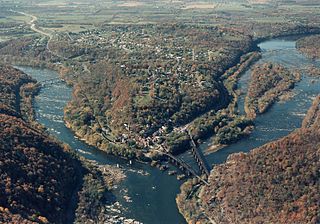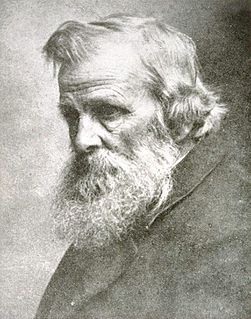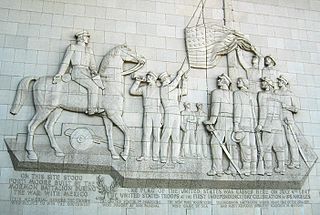
Essex is an unincorporated community on the east side of Rush Creek in the central part of Jackson Township, Union County, Ohio, United States. It is at 40°28′57″N83°18′57″W, at the intersection of State Routes 37 and 739.
Turkey is an unincorporated community in Breathitt County, Kentucky. It is located on Kentucky Route 30, between the communities of Lerose and Shoulderblade.
San Simon River is an ephemeral river, or stream running through the San Simon Valley in Graham and Cochise County, Arizona and Hidalgo County, New Mexico. Its mouth is at its confluence with the Gila River at Safford in Graham County. Its source is located at 31°51′21″N109°01′27″W.
Stein's Pass, is a gap or mountain pass through the Peloncillo Mountains of Hidalgo County, New Mexico. The pass was named after United States Army Major Enoch Steen, who camped nearby in 1856, as he explored the recently acquired Gadsden Purchase. The pass is in the form of a canyon cut though the mountains through which Steins Creek flows to the west just west of the apex of the pass to the canyon mouth at 32°13′19″N109°01′48″W.
Animas Valley Mall is an enclosed regional center shopping mall in Farmington, New Mexico. Its anchors are Sears, Dillard's, JCPenney, Ross Dress for Less, and Animas Cinema 10.
Whitewater Draw, originally Rio de Agua Prieta, [Spanish: river of dark water], is a tributary stream of the Rio de Agua Prieta in Cochise County, Arizona. It was called Blackwater Creek by Philip St. George Cooke when his command, the Mormon Battalion, camped at a spring on its course on December 5, 1846.
Playas Lake is a dry lake or playa in Hidalgo County, New Mexico, United States. It lies at an elevation of 4,278 feet / 1,304 meters. It consists of a long dry lake running north northwest south southeast within the Playas Valley between the Animas Mountains on the west and the Little Hatchet Mountains on the east.
Whitmire Spring is a spring in Hidalgo County, New Mexico. Correctly named on the Playas Lake South U. S. topographic map, it is mistakenly called Whitmore Spring on the U.S. Geological Survey Geographic Names Information System. The spring was named after J. B. Whitmire, a rancher in the 1880s, owner of the Whitmire Ranch. Whitmire Spring lies at an elevation of 4,291 feet / 1,308 meters, on the west shore of Playas Lake, near the site of the Whitmire Ranch. Whitmire Spring is one of a number of springs and seeps bordering the western edge of Playas Lake. Its water has its source in the Animas Mountains nearby to the west.
Cowboy Rim is a cliff that runs along the Continental Divide in the Animas Mountains of Hidalgo County, New Mexico. It runs west from a point at 31°36′34″N108°41′37″W to its highpoint is at an elevation of 6,591 feet / 2,009 meters at 31°36′36″N108°39′31″W just east of Elephant Butte. Here Cowboy Rim overlooks the Gillespie Creek valley below it to the north, and the Continental Divide runs along this section of the rim, then turns of to the south-southwest from the highpoint, along a ridge west of Elephant Butte Canyon. Cowboy Rim continues eastward to Elephant Butte then turns south-southeastward to 31°32′52″N108°37′22″W. This section of the Rim overlooks the Playas Valley below it to the east.
Bennett Creek is a tributary stream in Hidalgo County, New Mexico.
Gillespie Creek is an intermittent stream or arroyo in Hidalgo County, New Mexico. Gillespie Creek is 11 miles long, that heads in the Animas Mountains at 31°37′10″N108°42′40″W, and flows northeasterly until it ends in the Playas Valley, at an elevation of 4,587 feet / 1,398 meters. Its waters in flood would reach Playas Lake. Its mouth is located 24 miles south southeast of Animas. Bennett Creek is a tributary that has its confluence with Gillespie Creek at 31°38′56″N108°37′23″W an elevation of 4,902 feet / 1,494 meters.
Elephant Butte Canyon or Lawhorn Canyon is a canyon in the Animas Mountains of Hidalgo County, New Mexico. Its stream is a tributary of Walnut Creek. Its mouth is located at elevation 5,535 feet / 1,687 feet at its confluence with Walnut Creek, just below Lawhorn Tank. Its source is located at 3.5 miles north northeast of its mouth 31°36′25″N108°39′20″W at an elevation of 6,050 feet / 1,844 meters on the southwest slope of Elephant Butte.
Walnut Creek is an intermittent stream in Hidalgo County, New Mexico. It has its source in the Animas Mountains on the east slope of the Continental Divide at an elevation of 6,720 feet / 2,048 meters at 31°33′15″N108°41′37″W. Its mouth is located at an elevation of 4,524 feet / 1,379 meters where it subsides into the Playas Valley.
Animas Creek is an intermittent stream in the Animas Valley within Hidalgo County, New Mexico. Is source is located at the confluence of Foster Draw and Taylor Draw, at 31°30′28″N108°52′09″W an elevation of 5,151 feet / 1,570 meters. Its mouth is in the Animas Valley, in at an elevation of 4,662 feet / 1,421 meters. However topographic maps show its wash runs farther northward to the southern outskirts of Animas, New Mexico at 31°55′51″N108°49′36″W.
Taylor Draw is a valley and stream tributary to Animas Creek within Hidalgo County, New Mexico. Its mouth, located at its confluence with Foster Draw, is the source of Animas Creek, at an elevation of 5,151 feet / 1,570 meters in the Animas Valley. Its source is at 31°31′15″N108°48′40″W in the Animas Mountains.
Walnut Creek is a tributary stream of Animas Creek within Hidalgo County, New Mexico.
Whitmire Pass is a gap in the Animas Mountains in Hidalgo County, New Mexico. It lies at an elevation of 4,977 feet / 1,517 meters. The pass was named after J. B. Whitmire, a rancher in the 1880s, owner of the Whitmire Ranch that lies to the east of the pass, on the west shore of Playas Lake, nearby Whitmire Spring. Whitmire Creek flows from the west slope of the pass, into Animas Creek in the Animas Valley. Another unnamed arroyo runs eastward down into the Playas Valley, toward Playas Lake at Whitmire Spring.
Whitmire Creek is a stream tributary to Animas Creek within Hidalgo County, New Mexico. It is one of two creeks of that name that are tributary to Animas Creek in the Animas Valley. They both were named for J. B. Whitmire one of the first settlers that established the Whitmire Ranch in the area during the 1880s.
Whitmire Creek is a stream tributary to Animas Creek within Hidalgo County, New Mexico. Its source is in Whitmire Canyon in the Peloncillo Mountains in Cochise County, Arizona. It is one of two creeks of that name that are tributary to Animas Creek in the Animas Valley. They both were named for J. B. Whitmire one of the first settlers that established the Whitmire Ranch in the area during the 1880s.
Bull Creek is a stream tributary to Animas Creek within Hidalgo County, New Mexico. Bull Creek is located east of Animas Creek, flows westward down from its source at 31°39′54″N108°41′28″W, at an elevation of approximately 5720 feet / 1,743 meters in the Animas Mountains to the east of the valley. It flows northwest from the west slope of Gillespie Mountain, to its confluence with Animas Creek in the Animas Valley at an elevation of 4,869 feet / 1,484 meters.







